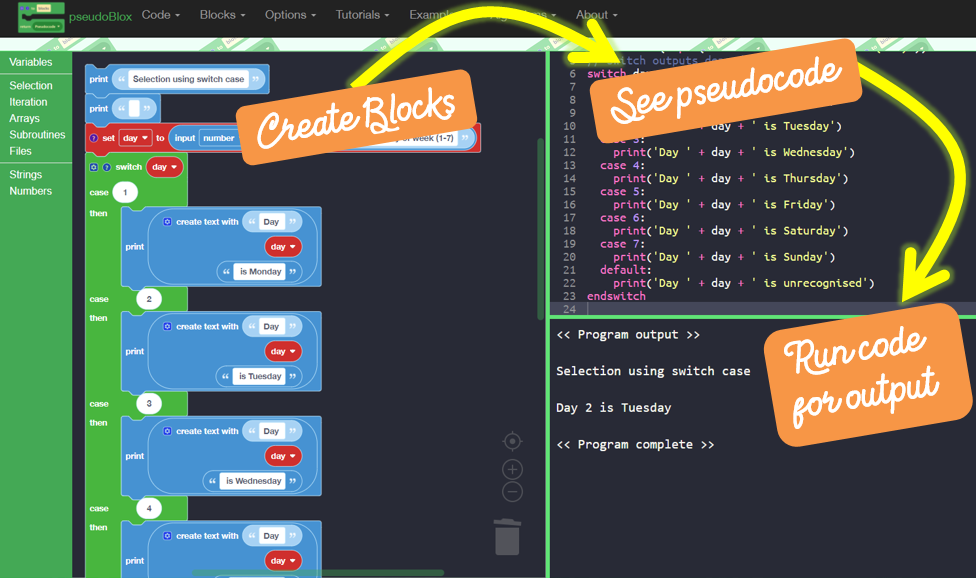pseudoBlox for GCSE OCR Computer Science
Bring pseudocode to life!
The best resource for Computer Science from ZigZag. Great job!
Build, run and save projects
Now your students can assemble working pseudocode, directly in a browser! Using a Scratch-like interface, students build ‘blocks’ of code. pseudoBlox then accurately converts these to OCR Exam Reference Language (ERL) AND shows the code output. A unique, fun, and accessible way for students of all abilities to build essential skills for the GCSE J277 exams.
Get started quickly
- Copy to your school network & run in the browser
- 19 short tutorial videos & 21 working examples (including 5 key algorithms)
- Use with the 7-lesson workbook as a stand-alone skills unit ➔ then embed into your teaching as a tool for working with pseudocode, including testing solutions for practice questions
Make pseudocode experts
- Builds understanding of OCR ERL and key programming concepts from sequence to validation
- Motivated students can experiment and test coding solutions quickly
- Plus! 10 additional built-in ‘challenges’ for independent learning
Usability for low-level attaining students is excellent... It can help those learners get over the line from grades 3 to 4...
...Subroutines (procedures and functions) are the biggest challenge to learners engaging with grade 7+ content, which has been done well in the task...
...It is common for students to pick a computer science for AL, having not done the GCSE, and this would undoubtedly be an asset to preliminary teaching and building code confidence

What do teachers say about this resource? (12056)
The interactive resource addresses the fundamental gap between moving from block-based to pseudocode (as well as the Python interpreter equivalent) ... The workbooks are great and help focus the learners on the programming constructs of the OCR exam specification. Especially Pages 4/5 address chr() and ord() libraries ... There are also similarities with the Edexcel specification (especially with their pseudocode in line with the block interfaces, such as using SET for variable and constant values.
I especially like the equivalency of the blocks to pseudocode; students traditionally need more content on selection statements, which this resource addresses. Python does not issue CASE statements (only SWITCH equivalents), and it is good the resource addresses this concept, especially with the exam focus on switching between both SELECTION statements.
A lot of time and effort has gone into the platform, and the use of the workbooks (for both students and teachers is solid). The knowledge quiz at the end of the section also establishes the fundamental knowledge students are expected to have in the exam and works nicely with the pseudocode booklets offered by OCR (J277 and legacy J276) specification. This has to be ultimately the best resource for Computer Science from ZigZag. Great Job, especially with the effort towards the use of subroutines! ... This is good for homework tasks and classwork. The students can download their work and easily submit it on the canvas platform (as an example) ... Customisation in the options menu is straightforward and helps with accessibility and modern dark mode standards ... That students have control over setting up the variable/constants at the start of the Bloc challenges is excellent, we always tell students to create the identifiers first in any program, and this addresses the misconceptions ... It addresses the misconception on the count controlled loop, e.g. when using FOR, students always omit the start of the range in the exams, and they are forced to place this in the block, which is fantastic, which deals with count controlled loops in reverse order (Page 16) ... Examples and focus on the algorithm (search and sorts) are solid! Very good and requires an incredible amount of effort ... usability for low-level attaining students is excellent and helps to deal with the basic programming constructs (Sequence, selection and iteration). It can help those learners get over the line from grades 3 to 4 ... Declaring arrays has been addressed (Page 19) and helps learners understand the array’s existence before adding values to this. The process is pretty straightforward (grey blocks especially!) ... Subroutines (procedures and functions) are the biggest challenge to learners engaging with grade 7+ content, which has been done well in the task. The function call (Page 24) is clear - students design in the subroutine first, then call the subroutine, which is done well in this task ... It is an immense help to the classroom ... It benefits the delivery, and building the blocks to see the pseudocode helps learners to establish how to end constructs and subroutines. The fact it creates the pseudocode in real time is a great asset to the product.
The content coverage addresses the J277 Paper 2 specification, and the workbooks follow the necessary order outlined in the specification.
Overall, the solid educational value could work for Edexcel specifications too ... The layout and presentation of the HTML file are solid and easily customised to fit each student’s needs (accessibility and dark mode). The visual representation also helps visual feedback methods in the classroom. The workbooks for the teacher and student are great and help with the journey from blocks to pseudocode ... The workbooks are superb and very colourful, and I cannot wait for this to go live ... it helps with the primary grade boundaries 3/4 and 6/7 ... I have noticed recently that the ZigZag resource links better to the specification flow available on the course specification. This is solid! ... it is common for students to pick a computer science for AL, having not done the GCSE, and this would undoubtedly be an asset to preliminary teaching and building code confidence.
This is a very well put together and developed resource with clean functionality and good aesthetics ... It is clearly well developed and tested. A lot of work has gone in to making the blocks compatible with ERL